Getting good results when surf fishing requires heading to the beach at the right time, but also choosing a good beach.
So after talking about the best time for surf fishing, let’s now talk about how to pick the perfect place to fish on the beach.
In this article, we’ll cover what to look for when choosing a place for surf fishing, how to read the beach, and what signs to watch for to find a great spot.
The 4 things to look for
When looking for a good location for surf fishing, there are 4 main things to keep on your radar:
1- Water turbulence
Water turbulence has a positive impact on surf fishing.
The first thing to note here is that a choppy surf puts more pressure on the seabed, which stirs up nutrients buried below the surface and therefore provides fish with a better food supply.
This activates the whole food chain in nearshore waters.
The small baitfish spot a greater abundance of nutrients to feed on, which causes them to venture out of their shelter and enter open waters.
This increases their vulnerability to larger predators, making them more susceptible to being hunted and caught.
Even sizable species that usually hold offshore are conditioned to approach the shore when it’s agitated.
They know that turbid water exposes more prey and therefore move closer to compete in the frenzy.
Turbid water also makes the surf more colorful and cloudy, providing better cover for the small fish to leave the shelter and search for food, and for the larger ones to ambush and surprise unwary prey.
Another reason predatory fish like to stand close to shore in rough surf conditions is that the waves and currents make it difficult for small fish to swim and navigate the water body.
In other words, choppy conditions disorient the small fish and exhaust them, making them much easier to hunt and pursue.
Opportunistically, large fish enjoy this because feeding becomes less energy-consuming.
The bottom line here is that water turbulence can bring more fish to the surf while encouraging them to feed more.
Therefore, surf fishing in such conditions will surely give you more rod shakes and catches.
Our survey provided clear evidence of this.
When we inquired about the key factor contributing to our readers success in surf fishing, the top response was the surf conditions, which garnered approximately 25.38% of the votes.
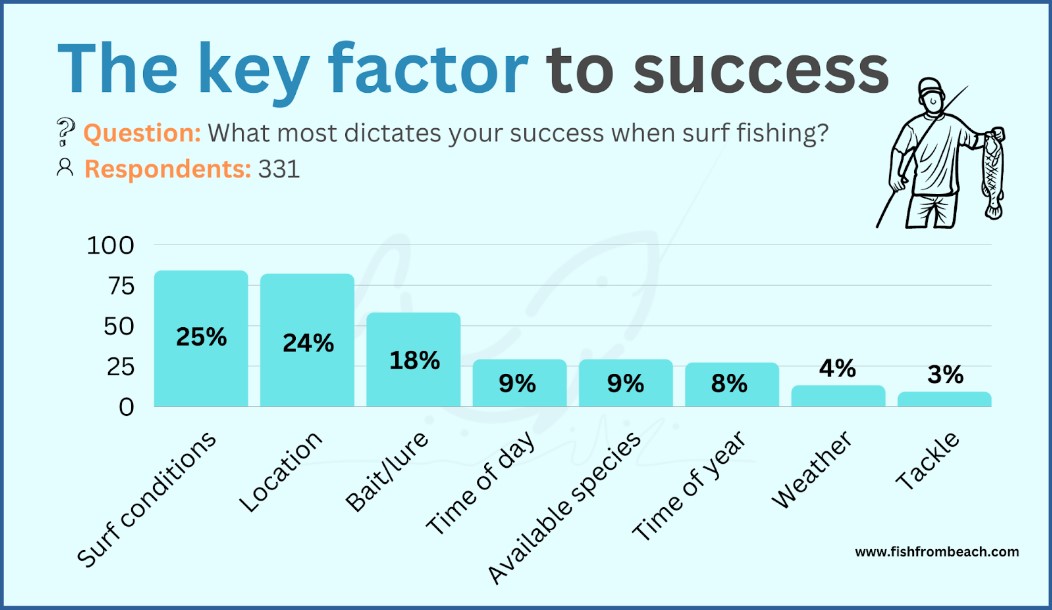
2 – Change of pace
What I mean by “change of pace” are areas where the speed of water suddenly goes up or down.
This quick change disorients the small fish and makes them easier to hunt.
In other words, when a school of baitfish passes through an area where the water speed either goes up or down, some fish get isolated and therefore become more exposed to the hungry predators lurking in the corners.
So opportunistically, game fish prefer to hold near similar places and wait for prey to swim by. This gives them easy access to food without consuming too much energy.
3 – Food and safety
Fish, especially those we encounter in the surf, are in constant search of a place where they can find two things:
Easy access to an abundant source of nutrients.
Safe place where they can hide and escape predators, and where they can breed comfortably and satisfy their biological needs.
So fish are always looking for these two elements.
This explains why some species keep migrating throughout the year and never settle in the same location.
The reason is that as they grow older or the weather changes, their needs and standards for food and safety change and therefore decide to move elsewhere where they can meet these new standards.
So before casting the line, look for areas where you think there is more food and safety for the fish.
We’ll give a few examples later on, but exploring the beach at low tide is an excellent practice to help you identify such areas.
So these were the 4 elements to look for when surf fishing. Water turbulence, change of pace, food, and safety.
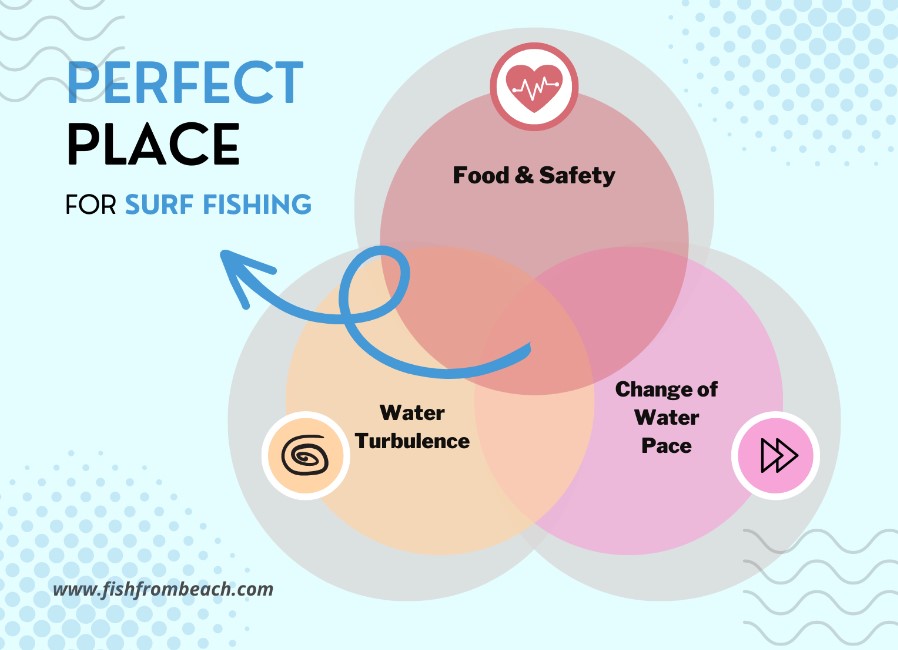
Now, of course, the ideal spot for any surf angler would be a location where all four of these elements come together.
However, it’s important to remember that catching fish from shore requires only one of these factors.
Don’t obsess over finding a spot that meets all four conditions – keep your expectations realistic and be content with whatever options are available to you.
In the following tips, we will discuss some examples that you can find in the surf and that incorporate one or more of the above criteria.
How to find a good beach for surf fishing?
With what we just discussed, let’s now discover the things to consider when choosing a beach for beach fishing.
Structures
A beach rich in rocky structures is likely to be rewarding
Underwater terrains rich in structures, rocks, kelp, and seaweed are arguably the most rewarding when surf fishing.
This is because the food chain is usually more concentrated in such places than in open waters with no structures.
On the one hand, small baitfish, invertebrates, and crustaceans like to concentrate in rocky areas and grass flats because that’s where food (mainly plankton) is most abundant, and also because that’s where it’s most safe to hold and feed.
And on the other hand, the aggregation of baitfish and shellfish encourages larger species to approach the shore and orbit around structured zones.
As a result, it’s likely to find more fish within your casting range if there is a fair amount of rocks, grass, and structures where you fish.
It’s like the entire food chain moves closer to your reach.
So keep this in mind. Surf fishing near jetties, piers, wrecks, and reefs can produce outstanding results.
That said, rocky zones increase the likelihood of your terminal gear getting tangled when you pick up the line or when fighting fish.
This can result in frequent tackle loss and a lot of dreaded moments.
So remember to make smart tackle choices when fishing rough grounds in order to reduce your snag rate.
Wave frequency matters
Another thing to consider when choosing a beach for surf fishing is the swell frequency.
The swell frequency is the amount of time between two consecutive waves. There are two things to remember here:
- Game fish usually collect their food from the sandbars where prey and baitfish concentrate
- The waves break and crest when they reach the sandbars
These two things mean that predatory fish feed in the same spot where the waves break.
Now since it’s more comfortable to feed when there is no wave breaking over your head and missing with your orientation and balance, game fish prefer to feed when there is little wave action above them.
Meaning, their feeding activity is limited to the brief time window between two consecutive waves. During this time window, game fish are not bothered to hunt and prey is more vulnerable due to the disorientation from the previous wave.
That’s where the swell frequency comes into play.
As a rule of thumb, the lower the frequency, the more time there is for predatory fish to find and pursue prey. In other words, a short frequency induces more feeding activity and hence better chances to hook up on something.
High frequencies do not give that much time to the fish and therefore can reduce the bite.
In my experience, I get the best results when the time between two waves exceeds 10 seconds.
The type of swell to avoid
Yes, water turbulence is good for surf fishing, but only to a certain degree.
In general, you shouldn’t expect much success when the swell is too high.
The first thing to note here is that large waves can pose a serious danger to surf fishermen standing on the shoreline.
Never underestimate the power of water. It only takes one strong wave to drag you out of your feet.
Personally, I wouldn’t risk casting the line if the swell exceeds 5 feet.
In my view, the potential rewards of fishing under such conditions do not outweigh the risks and challenges involved.
In other words, fishing a large swell is dangerous and not even worth it.
The presence of large waves creates significant water turbulence, which can be disorienting for many species of fish, including the large ones with strong swimming abilities and considerable power.
It doesn’t even need to affect the large fish.
All it takes to have mediocre results when fishing is to eradicate the base of the food chain and the top predators will systematically leave elsewhere in search of something to eat.
So it’s likely that you will find fewer fish within your casting range if the waves are too high.
Needless to say, heavy swells will also impact the stability of your terminal tackle and make it difficult for you to keep your bait where you want it to be.
Bite detection is also more difficult during a strong wave action, as your rod will keep bouncing and shaking, giving no clear signal whether it’s a bite or just the wave effect.
The difference between gentle and steep beaches
When beach fishing, you will either cast the line into a steep or gradual shore.
A steep shore is marked by a sharp drop-off in the sea floor that causes the water to become deep at a short distance from the beach.
In other words, a steep beach is when the first sandbar is abrupt and located very close to the shore.
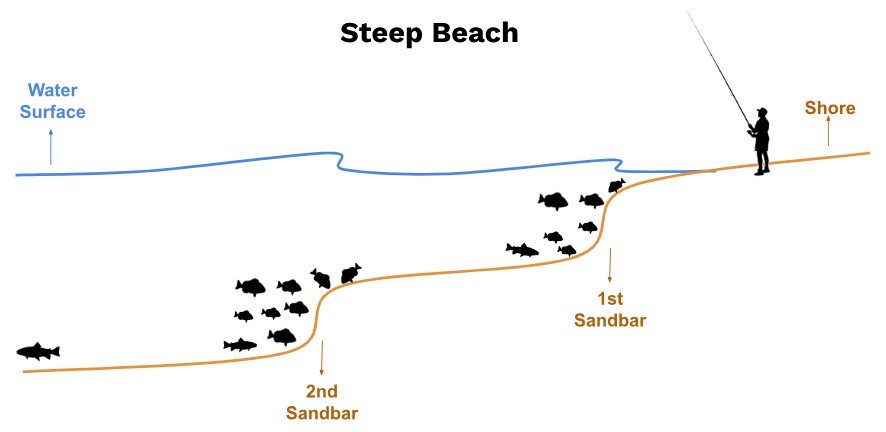
A gradual beach, on the other hand, is when the water gradually gets deeper as you move away from the shore. This means that the first sandbar of a gradual beach slopes gently over a long distance from the shoreline.
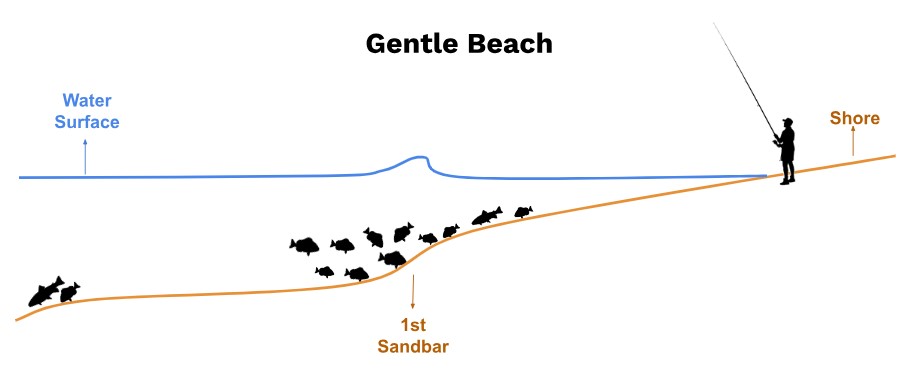
Both steep and gradual shores are rewarding for surf anglers. They simply require different techniques and approaches.
As a general rule, we can consider gentle beaches to be more beginner-friendly.
When sandbars lay and develop over a long distance, fish find more space to look for food and avoid predators. As a result, they spread over a wider area, which increases your chances of landing on a productive spot.
In other words, beginners can get away with average casting accuracy when fishing a gentle beach.
Steep beaches on the other hand are more demanding in terms of casting skills. When there are sharp drop-offs and sandbars on the underwater terrain, fish become forced to concentrate in tighter zones to compete for food, territory, and security. This limits you in terms of where to deploy your bait and the risk of landing on a ghosted area gets higher.
This is not to say that steep beaches are not good for surf fishing.
In fact, steep beaches often produce unforgettable experiences and memories. If you manage to accurately place your baits in the right spot repeatedly, you’ll notice a significant increase in the number of bites and catches compared to fishing on a gentle beach. Stability is also more vital in steep beaches. You cannot let the currents drift your bait away when fish are aggregating in tight zones.
An easy way to tell if the surf is steep or gradual is by observing how the waves develop and break.
Waves that break far away from the shore and keep rolling over a big distance indicate that there is a gentle slope on the seafloor and therefore you have a wider space where to put your baits.
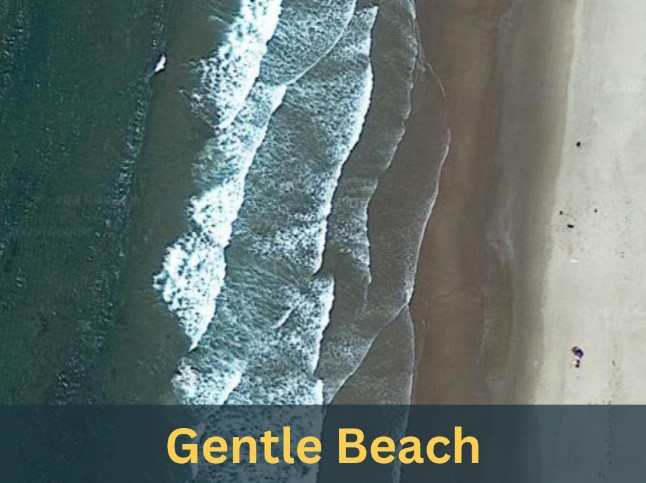
Conversely, when there is a sharp cut-off between blue and white waters, it indicates that the drop-off underneath is sharp and tilted, which as we said requires a good casting precision.
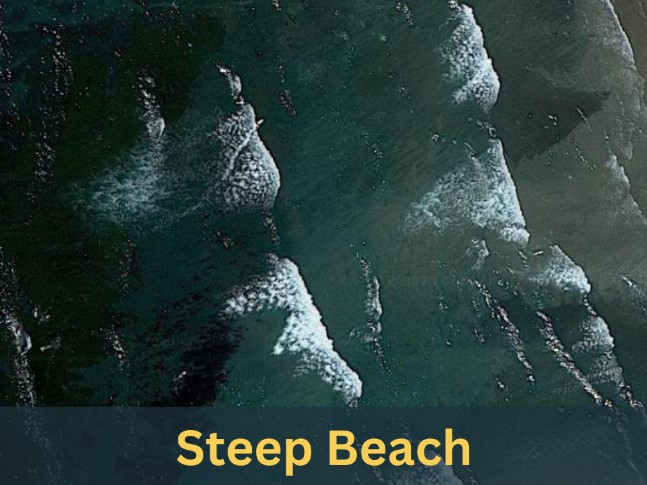
Put differently, the more white water you see in the surf, the more likely it’s a gentle beach with gradual drop-offs and sandbars.
How to read the beach?
Once you find a good place for surf fishing, it’s now time to read the beach and identify where to deploy your baits.
The thing to know here is that most beaches are made up of 3 structures :
The sandbars: The sandbars or sandbanks are bars of sand or coarse sediment that form underwater and run parallel to the shoreline. As a general rule, on any beach, you should find 2 to 3 sandbars separating the shore from the open sea.
The troughs: The troughs are the hollows or deep zones between 2 parallel sandbars.
The rip channels: The rip channels are the openings that break the sandbars allowing a current (called the rip current) to run out to the open sea.
We will give further explanation on how to identify each of these structures, but practically, all you need to do is to identify the sandbars.
Once you find them, it will be easier to guess where the troughs and channels are.
The sandbars can be revealed by the cresting white water that forms when the breaking waves approach the shore.
When the white water appears, it indicates that there is a bump on the underwater terrain which forces the waves to rise and crash.
That’s where the sandbars are located.
Now, once you locate two sandbars running parallel to each other, look for the deep and dark waters between them. These are the troughs.
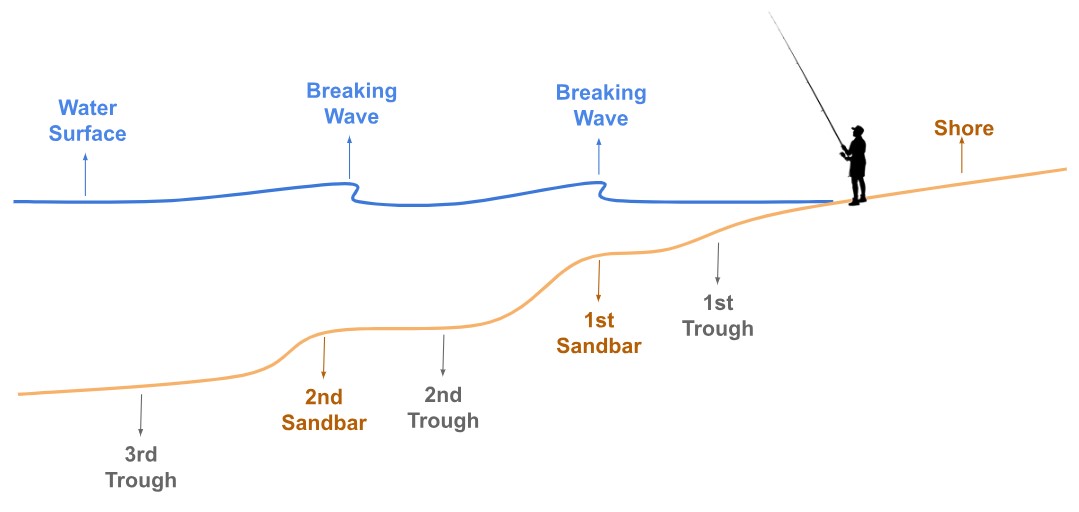
Finally, look for openings that are perpendicular to the shoreline and break the sandbars. These are the rip channels.
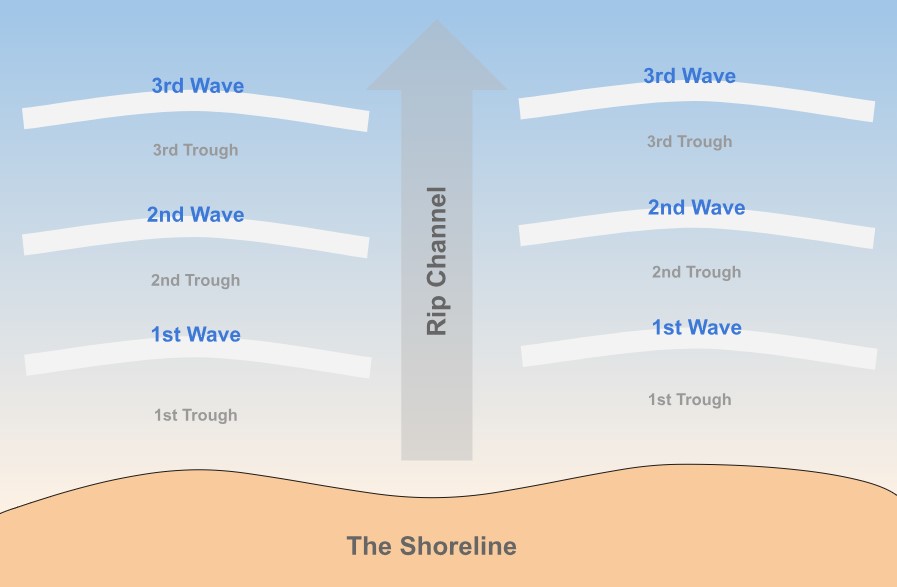
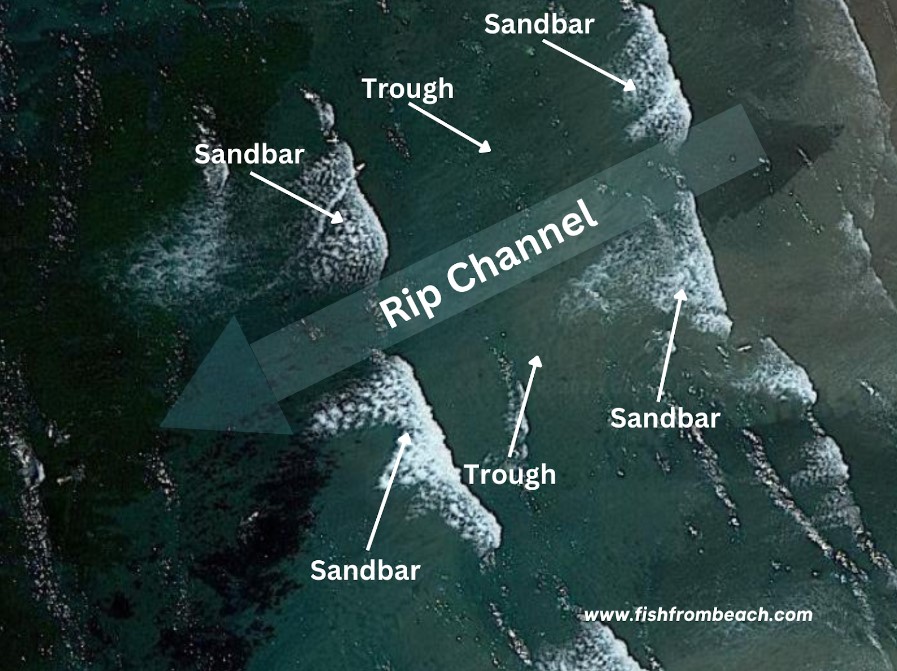
As I said, the following tips will dive deeper into each of these elements and how to identify them, but don’t worry if you find it difficult to read the beach on your first trips.
With little experience and practice, you will be more familiar with the underwater topology and the main structures of any beach.
The first thing to locate
Sandbars are the first thing to locate when reading the beach.
As we said, sandbars are small underwater formations that create bumps on the seafloor and help to break the waves before they reach the shore.
So, an easy way to find the sandbars is to locate where the waves break, forming the famous white and cresting water we all know.
Generally speaking, you should be able to locate 2-3 rows of sandbars running parallel to the shoreline wherever you stand on the beach.
The reason sandbars are great spots to target when surf fishing is that when the waves roll over and crash, they create water turbulence, which as we said, agitates the seabed and uncovers buried food items, making them easily accessible to the fish.
As a result, fish like to aggregate around sandbars to benefit from the greater abundance of food sources, making them ideal locations to place your bait.
With this in mind, please note that only small and medium-sized fish are more likely to be found around sandbars.
Bigger fish typically prefer to stay in the deep troughs between sandbars and wait for the waves to disorient and disturb prey.
To put it another way, game fish tend to swim up to the sandbars only to take advantage of the water turbulence and catch prey.
Once they’ve done that, they usually leave the bars and return to the deep troughs on the sides.
Nevertheless, you don’t necessarily need to place your bait inside the troughs to attract big fish.
The key point to remember here is that large fish use the troughs primarily as pathways and navigation channels, rather than feeding areas. They are more accustomed to feeding on the sandbars.
So your bait inside the troughs is likely to look suspicious to the fish.
In other words, casting into the sandbars is the most effective way to target both panfish and larger game species.
Another good thing to know here is that large fish are usually found around the sandbars.
So an effective way to reduce bites from the unwanted, small species is to target the edges of the sandbars, not the top.
Also, it’s preferable to target the seaside of the sandbars. Why? because if you deploy your bait on the shore side, It is likely that the wave action will push it towards the trough and this is not where you want to be.
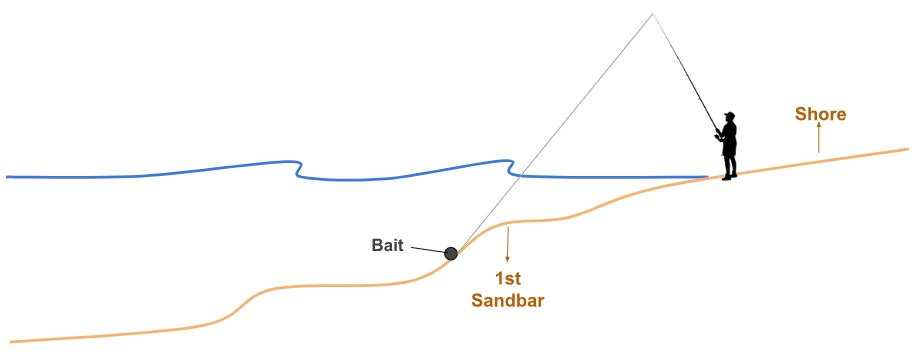
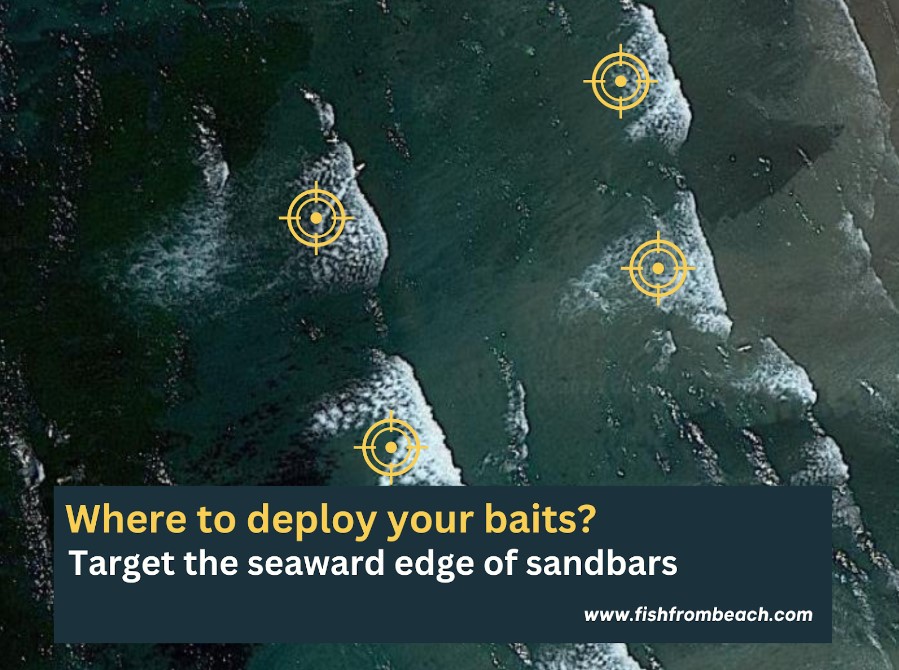
Rip currents
Rip currents are strong, narrow currents that flow outwards from the shore, typically perpendicular to the beach. These currents can be hazardous to swimmers and surfers, but they also create unique opportunities for surf fishing.
One reason why rip currents are great spots for surf fishing is that they often carry baitfish and other prey out to deeper water, which attracts large predatory fish.
In other words, offshore fish use the rip current as a channel to approach inshore waters and meet the food as it heads to the open sea.
So what you want to do here is to cast inside the channel so that your bait joins the food that offshore fish encounter as they get closer.
Another reason why rip currents are great spots for surf fishing is that as the current moves, it stirs up the ocean floor, exposing crustaceans and other bottom-dwelling creatures that fish feed on.
Additionally, the outgoing current inside the channel will often pull your baited rig seaward, increasing your casting reach.
As we said, an easy way to locate rip channels is to look for discontinuities in the cresting, white water that the waves produce.
In fact, we can consider the rip channels as openings that break the sandbars. So look for long openings that go perpendicular to the beach and sandbars.
In addition, rip currents often create a visible line of foam or debris on the surface of water, which can serve as a visual cue for fishermen to target their casts.
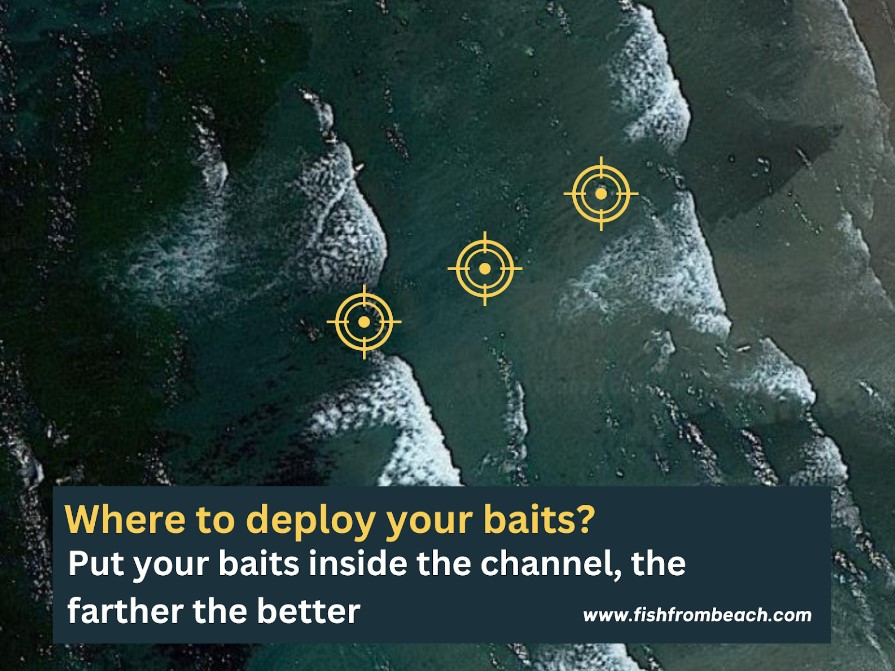
The sweet spot
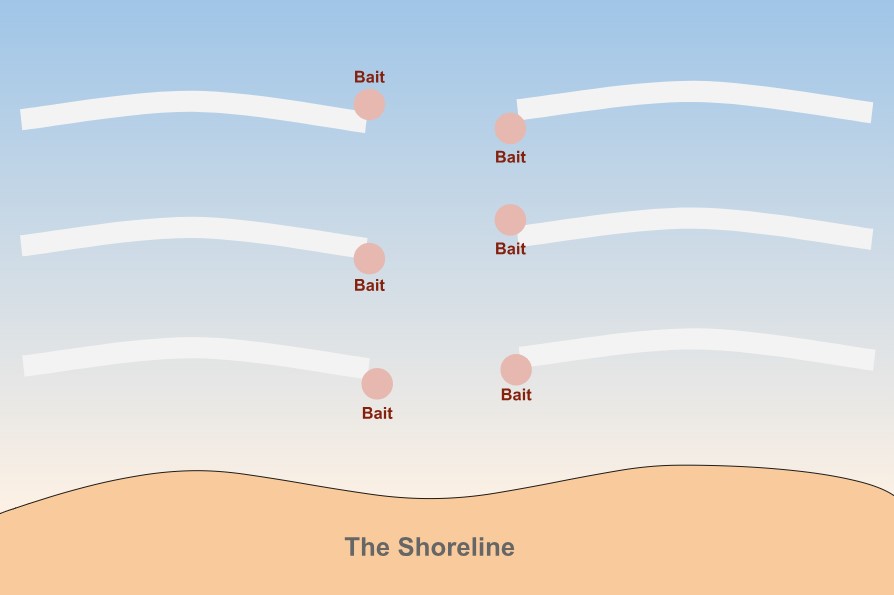
With the above being said, we can conclude that a good spot to target when surf fishing is where a sandbar meets the rip channel.
First of all, such a zone undergoes a strong change in current rhythm, which is very beneficial for game fish in search of easy prey.
Second, by targeting the extreme sides of sandbars, you place your offerings on the bars where the small and medium-sized fish feel comfortable to hold and eat, but also near the channel, where the big players look for prey and baitfish.
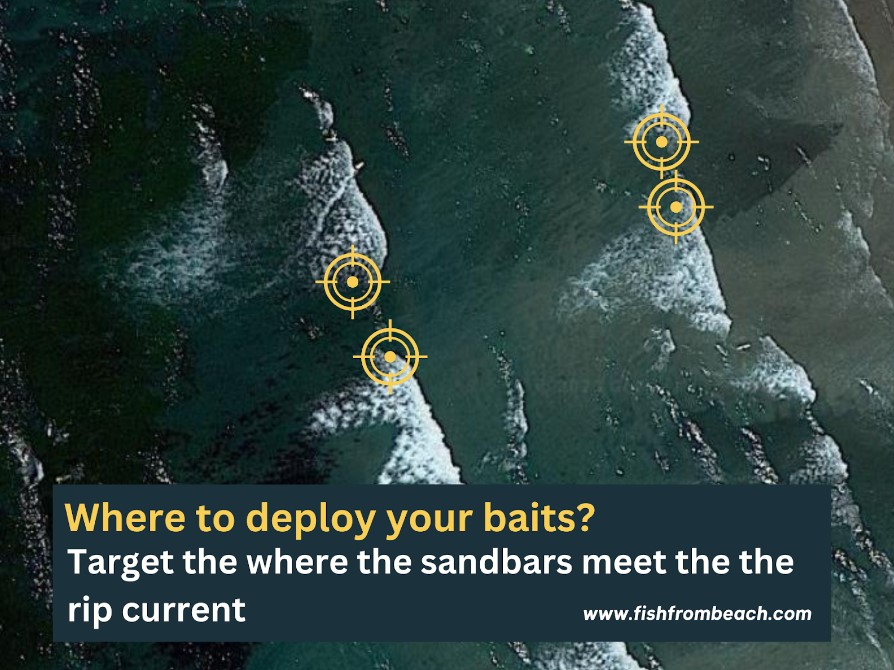
Low salinity channels
Low salinity channels are also great places for surf fishing.
This includes river mouths, creeks, estuaries, passes, inlets, grass flats, etc.
A lot of surf anglers swear by such waterways and they have many arguments to support that.
First, passes and inlets are generally shallower than open waters and richer in structures, grass, and mud. Therefore, panfish and many bigger species find them a safer place to be since predators do not normally get there.
Additionally, low salinity channels usually contain high nutrient levels that are carried from the rivers and roads towards the sea.
This influx of nutrients creates a good food supply that attracts a diverse range of fish, resulting in a high concentration of fish in these areas.
Moreover, there are usually strong currents flowing inside these waterways, which makes pursuing prey a lot easier and less energy-consuming.
Opportunistically, game fish like to concentrate inside these channels and hold against the current waiting for the overwhelmed baitfish to pass by.
Another reason you are likely to find more fish inside low salinity channels is that they are good for spawning.
The strong currents inside these streams allow fish to distribute their eggs over a wider area, which enhances the chances of survival for the young fish.
So depending on the season and time of the year, it’s not surprising to find large schools of some fish species having their spawning season there.
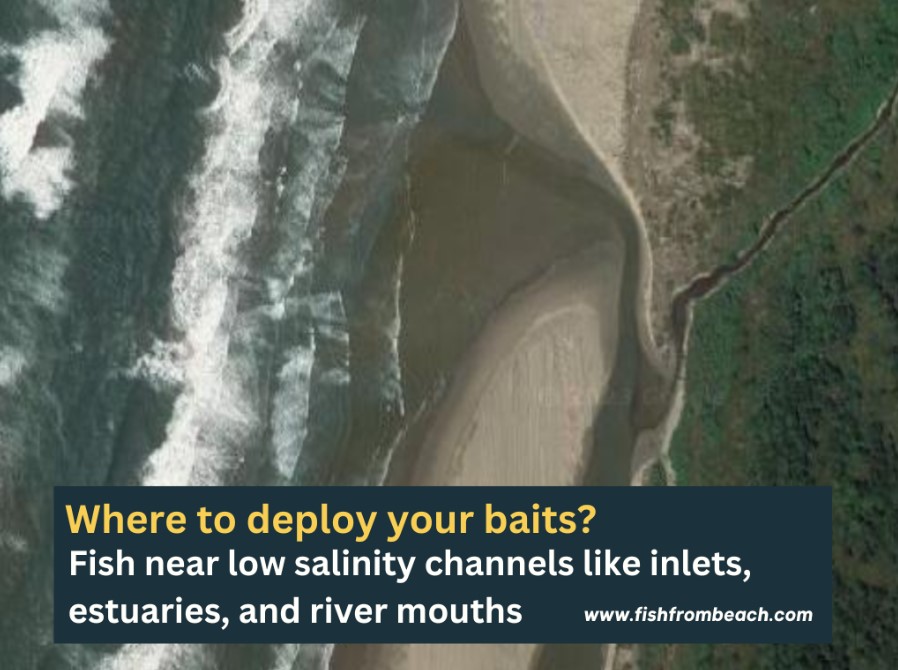
Holes
Holes are zones on the seabed that are deeper than others.
They are like sand pockets where the underwater terrain suddenly gets deeper and then goes back to its normal depth.
In general, you should be able to identify a few holes wherever you fish, but sometimes it’s quite hard to find them, especially at high tide when the sea level is high.
The best way to find holes is to look for small areas on the water surface with a darker color.
Another indicator of holes are areas where the white water of the breaking waves suddenly vanishes but rapidly resurfaces.
What makes holes perfect for surf fishing is that they are often characterized by a sudden drop in current pace, which, as we said, makes it easier for game fish to hunt disoriented prey.
Also, small fish like to hold inside the holes so they can take a break from the heavy, overwhelming currents.
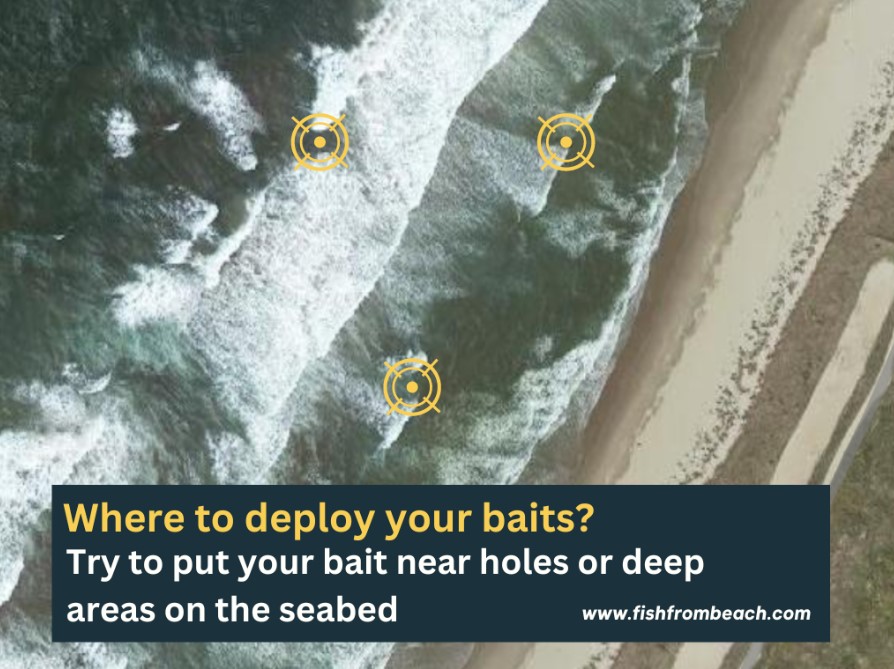
Points
A point is where there is a sudden change in depth on the underwater terrain.
It could be a rock pile or bump at the bottom or just a sloping sand formation built up from recent wave activity.
As with holes, there is usually a change in water rhythm near the points, which encourages game fish to aggregate around and wait for baitfish to get disoriented by the changing currents.
In order to locate the points, observe the water surface and try to find areas where the water level is consistently higher than what you see in the rest of the surf.
Another easy way to find the points is to look for white, cresting waters that are not caused by the waves.
Cresting water almost always indicates that there is a bump on the seabed and therefore it’s an excellent spot to target.
It’s also worth noting that there is often a hole near a point.
Bumps usually form by accumulating sand from adjacent terrain, which eventually creates holes and deeper spots in the area.
So finding a hole can lead you to a point and vice versa. Two birds with one stone.
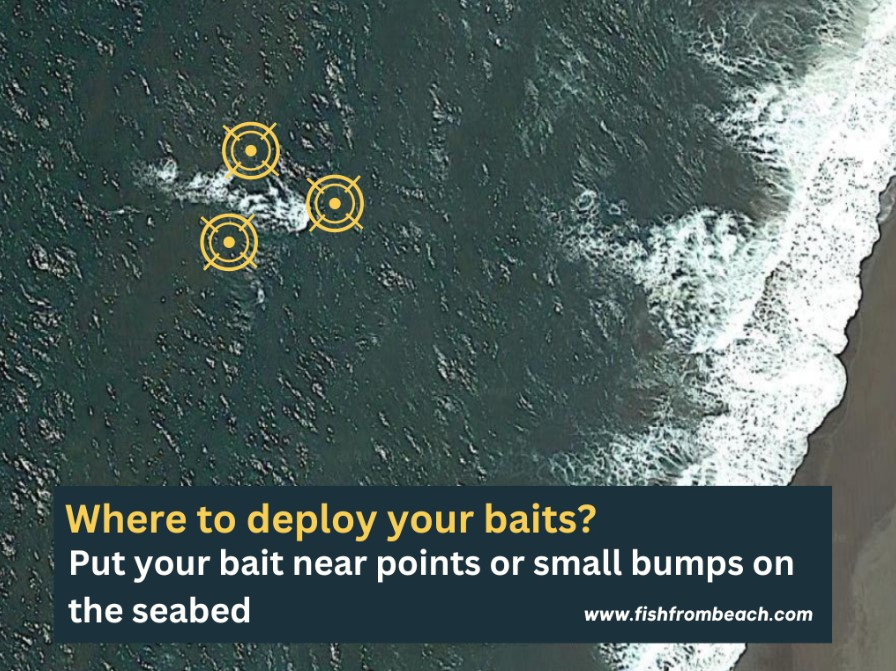
Baitfish schools
When searching for a suitable place for surf fishing, it’s helpful to consider the presence of baitfish schools in the area.
Baitfish are a primary food source for many saltwater species, and their presence often indicates the presence of larger predators too.
Overall, schools of baitfish can be found in areas with good water circulation and nutrients.
One way to locate them is to look for signs of their presence on the water’s surface, such as small ripples or disturbances caused by their movement.
Also, keep an eye on diving seabirds, as they often indicate the presence of baitfish near the surface.
Many bird species, such as seagulls, sandpipers, and pelicans are known to feed on fish and will often fly over areas where there is an abundance of prey. So watching the flight patterns of these birds can give you a good idea of where fish are concentrated and therefore where to direct your casts.
For example, if you see seagulls diving into the water to feed on baitfish, this can suggest that larger game fish are in the area, probably feeding on the same baitfish.
Another effective way to locate baitfish is to use a fishfinder, which uses sonar technology to detect schools of fish in the water column.
Experience and knowledge are also important here. For example, it’s known that large schools of mullet migrate along the Atlantic and Gulf coasts of the United States each year during the fall months, from September to November.
Mullet is a favorite food for many game fish such as redfish and tarpon. The fall is therefore a great period to target these species.
Note (*): If you make a purchase through links from this website, we may get a small share of the sale from Amazon or other similar affiliate programs.
Surf Fishing Survey
Help us provide you with better content by answering simple questions about your surf fishing experience and knowledge.
We will put the collected responses together and turn them into valuable information that will help you catch more fish from shore 😉
Note: No personal information will be collected with your answer.
